Ready to learn the secrets behind seo for small businesses?
Well, we hate to break it to you, but there are no secrets. To make SEO work for your business, you need a thorough understanding of what your ideal customer is searching for – and why they want it.
The fact that there is no big secret is what makes SEO so hard to pin down. It’s a constantly moving target. Google’s SEO algorithms are continuously changing to deliver the best answers to search results.
There’s no way to get around it and Google will penalise your content if you try. Yet, there are fundamentals we can’t afford to miss, and we will cover all that for you in this blog.
Here are some basic SEO tactics that you can start implementing right away to get your website optimised.
1. On-Page Optimisation
On-page optimisation refers to optimising various elements directly on your website. Here are a few key points to consider:
Title tags and headings: Craft compelling and descriptive title tags for each page, incorporating relevant keywords where appropriate.
Similarly, use heading tags (H1, H2, etc.) to structure your content effectively, making it easier for search engines and users to understand the hierarchy and relevance of the information.
URL structure: Create clean and user-friendly URLs that include relevant keywords. A clear URL structure helps search engines and users easily comprehend the page’s content. Avoid using generic or lengthy URLs; opt for concise and descriptive ones.
Here’s how this works with neStripes:
- www.netstripes.com is the official domain
2. https://netstripes.com/website-design-development-sydney/ is the URL for a web page ranking for the keyword “website design development”.
Image optimisation: Optimise your images by compressing them without compromising quality, reducing file sizes and improving page loading speed.
Add descriptive alt text to images, using relevant keywords where appropriate. Consider using descriptive filenames that reflect the content or context of the image.
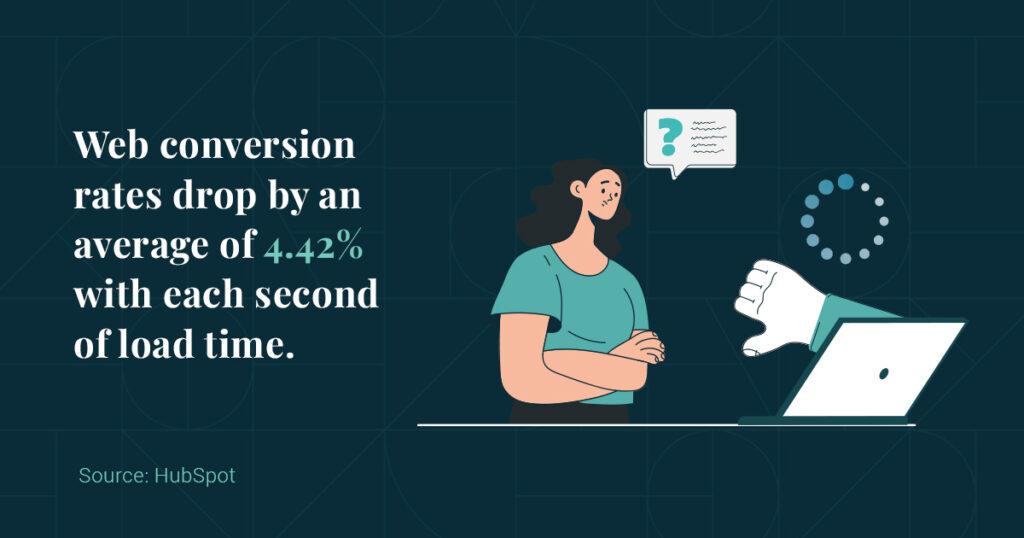
Page speed: A slow-to-load website can drive away potential visitors and even those who click on your ads, which can be costly. Your website needs to grab visitors’ attention within 2-4 seconds, or they will lose interest.
Often, slow loading speed is caused by the website’s design or, in more serious cases, a slow server. To speed up your website, consider removing unnecessary plugins, optimising images, and enabling compression.
For more information about on-page optimisation seo for small businesses, check out this blog.
2. Meta Descriptions
Meta descriptions concisely summarise your web pages in search engine results. Here are a few key points to consider:
Compelling and concise: Craft meta descriptions that accurately represent your content and entice users to click through to your website.
Keep them within the recommended character limit (typically around 150-160 characters) to ensure they display properly in search engine results.

a blog on top 5 online advertising trends.
Include relevant keywords: Incorporate relevant keywords naturally within your meta descriptions to improve their visibility in search engine results. This can help search engines and users understand the relevance of your page to their search queries.
Unique and informative: Avoid using duplicate meta descriptions across multiple pages. Each meta description should be unique and overview the page’s content. Ensure it accurately reflects the specific information or value offered on that page.
3. Keyword Research
Keyword research is a crucial element of your SEO strategy. By finding and focusing on the appropriate keywords, you can enhance your website’s content to align with the objectives of your intended audience.
Here are a few key points to consider:
Understanding your audience: Conducting effective keyword research to understand your target audience is essential. Identifying customer needs, preferences, and search behaviour will help you determine the most relevant keywords to target.
Keyword tools: Utilise various keyword research tools, such as Google Keyword Planner, SEMrush, or Ahrefs, to identify high-value keywords with decent search volume and relatively low competition. These tools provide insights into keyword trends, search volume, and related keyword suggestions.
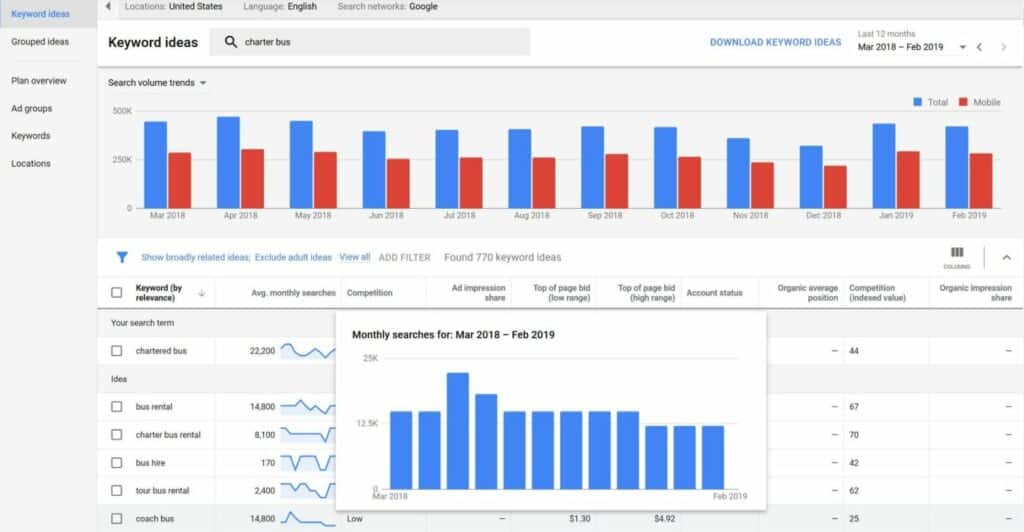
Long-tail keywords: Consider targeting long-tail keywords (more specific phrases with lower search volume) alongside broader keywords. For example, a keyword would be ‘digital marketing’, and a long-tail-keyword ‘how to create a good digital advertising strategy’.
Long-tail keywords often have less competition and can lead to higher conversion rates as they reflect more specific user intent. For example, if you run a restaurant that specialises in organic coffee beans, then your long tail keywords should be something like “organic coffee near me” or “organic coffee Sydney CBD” since this is what costumes will be searching for.
4. Link Building
Building high-quality backlinks to your website is crucial for improving your search engine rankings. Here are a few key points to consider:
Quality over quantity: Focus on acquiring backlinks from reputable and authoritative websites within your industry. A few high-quality backlinks from trustworthy sources can have a more significant impact than numerous low-quality ones. Listing your business in reputable online directories like Clutch, Urban List and GoodFirms, can increase the number of backlinks and improve search engine rankings.
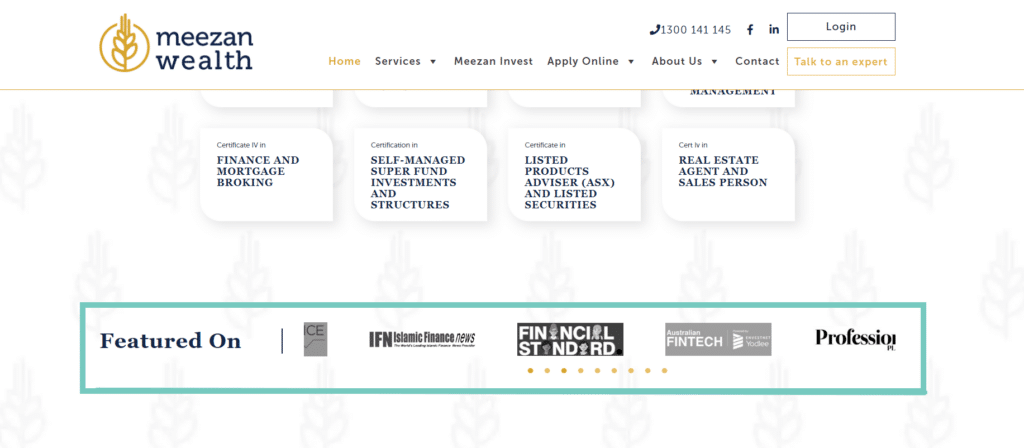
which provides excellent backlinks to their website.
Guest blogging: Develop relationships with influential bloggers or websites in your industry and offer to write informative and engaging guest posts for their platforms.
In return, include a link to your website within the content or author bio. Guest blogging not only helps establish your authority but also generates valuable backlinks.
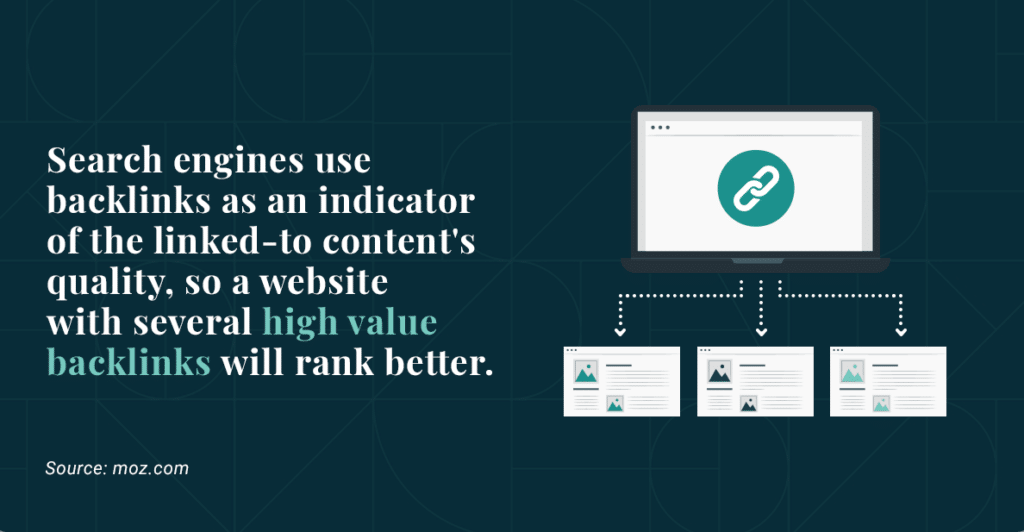
Social media promotion: Leverage your social media presence to share your website’s content. When your content is shared and linked to social media platforms, it increases the likelihood of other websites discovering and linking back to your valuable resources.
5. SEO Landing Pages
An SEO Landing Page is a web page created to attract visitors and rank for specific keywords. It aims to convert visitors into customers using persuasive language and effective design.
It is important to strike a balance between optimising for SEO and creating content that resonates with human readers.

Example: we created an SEO landing page for the keyword “website designing in Sydney”, and optimised the content for this specific search term.
This way, you can improve your website’s search engine rankings while delivering a valuable user experience.
- Design landing pages with a clear purpose and call to action.
- Optimise the content and structure of your landing pages to align with specific keywords or advertising campaigns.
- Ensure fast page loading times, mobile responsiveness, and intuitive navigation.
- Test different variations and elements of your landing pages to improve conversion rates and user experience.
6. Contact Pages
Your contact page is essential to your website, providing visitors with a direct means to contact you. By optimising your contact page for relevant keywords and incorporating location-specific information, you can increase its visibility in search engine results.
This makes it easier for potential customers or clients to find and contact you, ultimately driving more organic traffic to your website.
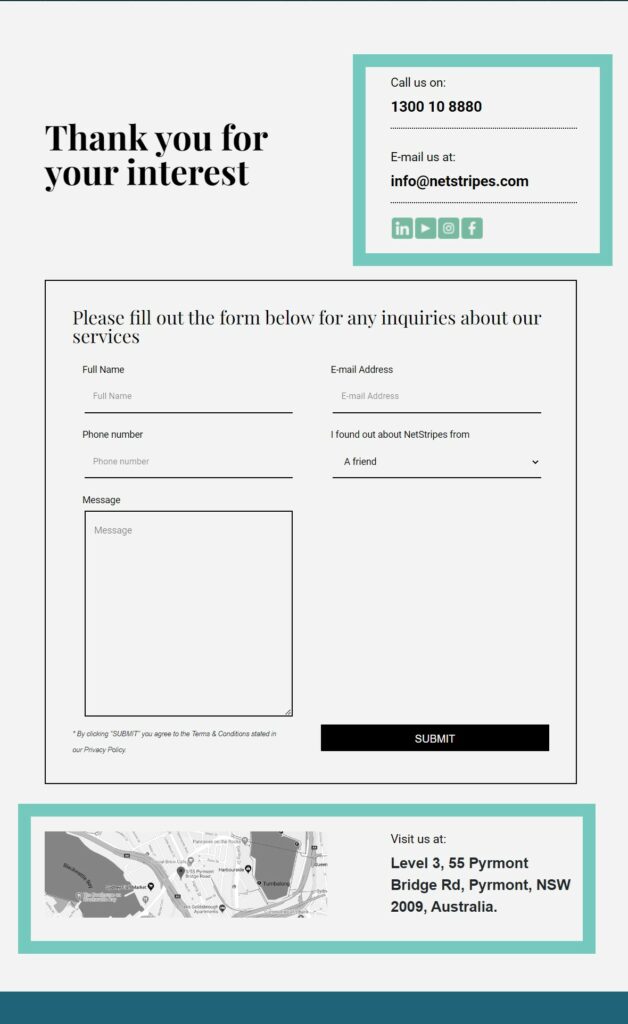
- Make it easy for users to find your contact information by providing clear and accessible contact forms, phone numbers, and addresses.
- Consider including a map if you have a physical location. optimise the contact forms for a better user experience, ensuring they are easy to fill out and submit.
7. Blog Posts
Blogs are an integral part of seo for small businesses because they provide fresh and relevant content with target-specific keywords, facilitate internal and external linking, encourage social sharing and backlinks, and enhance the overall user experience.
By leveraging blogs effectively, you can improve seo for small businesses visibility and organic search rankings and ultimately attract more targeted traffic. Here are a few tips to help optimise your blogs.
- Create informative and valuable blog posts that address the needs and interests of your target audience.
- Conduct keyword research to identify relevant topics and incorporate targeted keywords naturally throughout your blog posts.
- Use headings, subheadings, and bullet points to enhance readability.
- Encourage social sharing and engagement by integrating social media buttons and commenting systems.
8. Videos
Incorporating videos effectively into your SEO strategy offers several advantages, including increased visibility in search results, diversified content formats, the potential for social sharing and backlinks and leveraging platforms like YouTube.
Shareable content: If your videos are informative, entertaining, or valuable, viewers may share them on social media platforms, potentially amplifying your brand’s reach and attracting more traffic to your website.
Link your videos: videos are more likely to receive backlinks from other websites or blogs, contributing to your site’s authority and search engine rankings.
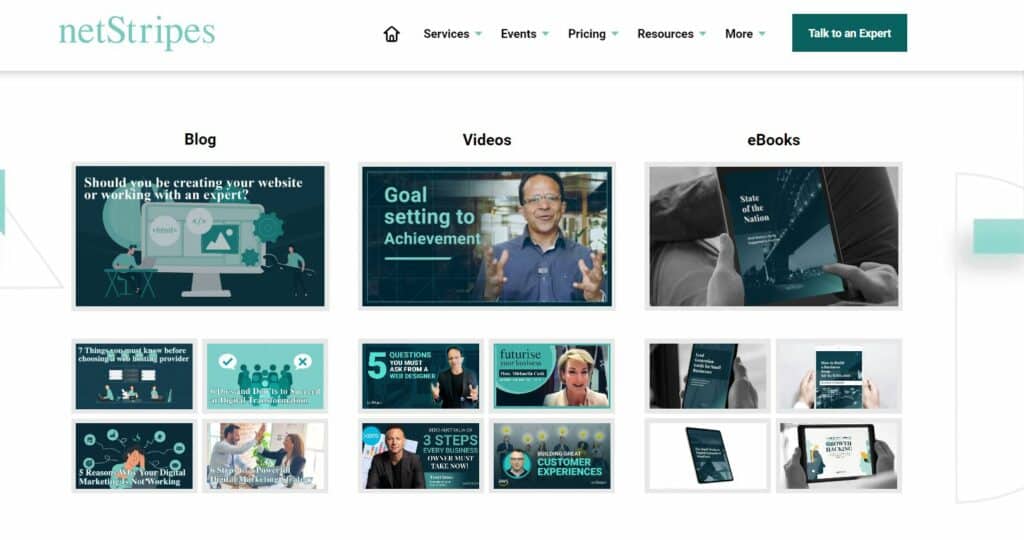
to improve user engagement.
Embed your content: Embed videos on relevant web pages to improve user engagement and encourage longer page visits.
SEO optimise videos: Use relevant keywords in video titles, descriptions, and tags, and transcribe content to make it accessible for search engines to understand and index.
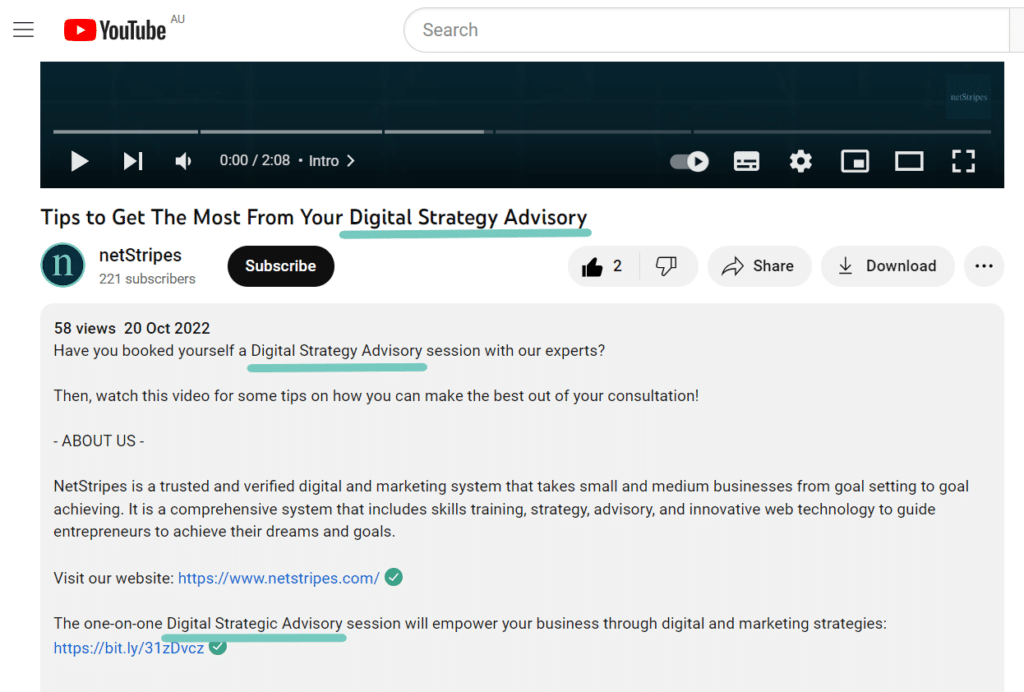
in titles, descriptions, and tags to make it easily identifiable to search engines.
Remember, these strategies are just a starting point, and the world of seo for small businesses is ever-evolving. If you want to learn more, we recommend talking to our digital specialists who can help you create and implement your SEO strategy.

Your first step to building a world-class website starts here.
A trusted brand is priceless for any business. We will help you build a compelling website that is respected in your industry and stands apart from your competition.



